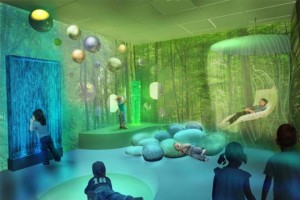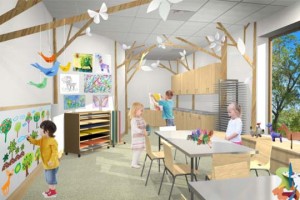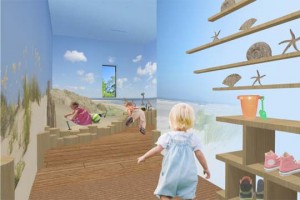Over the last several weeks, we’ve looked at some of the key guidelines and issues related to “Design for Autism.” To wrap up this series, we’ll talk about an example of how Cloudberry is trying to put design for Autism into practice — at LifeTown, a new center for recreation, education, therapy, and leadership training currently under construction by Friendship Circle in Livingston, NJ.
To quickly recap the previous posts, Autism is a sensory processing disorder that leads to sensitivity to environmental stimuli. When designing with Autism in mind, some recommended guidelines include:
• Maintain “object in content”: People with Autism have an acute visual memory and rely heavily on environmental cues to understand the world around them, so it’s important that environments and experiences be designed to support expectations of sameness.
• Facilitate sensory integration: Environmental design should be kept simple, so children are able to focus. For example, select soothing hues, use natural lighting instead of flickering fluorescents, and provide quiet spaces for “escape”.
• Set expectations: Many children with Autism are able to participate in and enjoy an experience more fully if they are able to “prep” for it in advance, so that they understand what the experience will be.
In our design work for LifeTown, we’ve tried to incorporate many of these guidelines, as well as other considerations. Some experiences are intended primarily for children with Autism and other special needs, including:
• The Sensory Play Room is an engaging physical play space for children that will be used for a combination of open play, physical therapy, and Friendship Circle programs. Clearly designated areas are set aside for different experiences, including quieter areas to rest or “escape”. The environment is made more immersive and more familiar by layering in a nature theme through graphic treatments and other design elements, so that the space resembles a park — the nature theme is also echoed in other spaces throughout LifeTown, to provide a sense of continuity.
• The Sand Room is a multi-sensory experience that evokes the familiar sights, sounds, and textures of a beach in a gentle way. A soft breeze blows, and the sound of waves helps build the experience.
• The Snoezelen Room is a calm, safe space with off-the-shelf Snoezelen modules that support a variety of physical and sensory therapy experiences. Design elements evoke the look and feel of a magical forest at night, enhancing this experience and connecting it to the nature theme throughout.

Our design approach had to find a balance among a variety of aesthetic, experiential, and physical needs. We focused first on the fundamental design requirements for a general audience, and then iterated the design to emphasize simplicity, continuity, and familiarity in order to better accommodate those with special needs.
For example, the Art Room is a creative space that supports programming for both adults and children, with all the functionality and materials of a full art studio. But it also includes design elements that integrate thematically with the other sensory-focused spaces at LifeTown, such as wall treatments with simple images of trees, leaves, and other nature-based patterns.

Throughout the building, a Wayfinding System helps orient visitors and guide them through the building, whatever their age or needs. It begins with a large, color-coded map on the lobby wall to set expectations about the experiences inside. The wayfinding system also includes simple, familiar images related to natural and urban environments, which connect visually to both the nature-themed sensory spaces.
In all of these ways, Cloudberry is trying to design for the special needs of Autism, while also practicing good experiential design in general.

